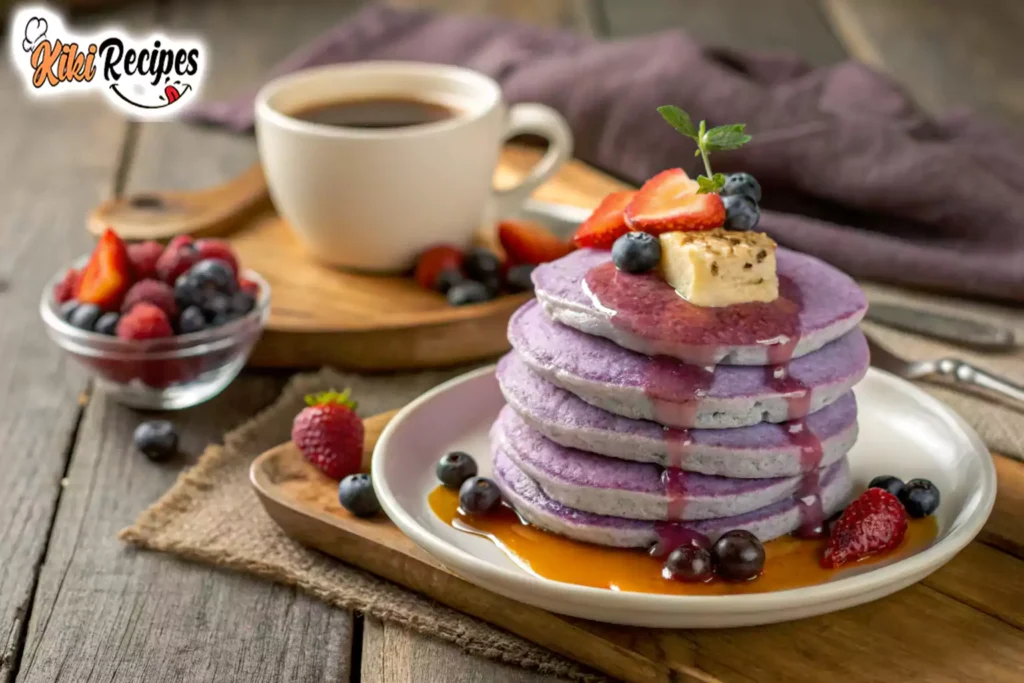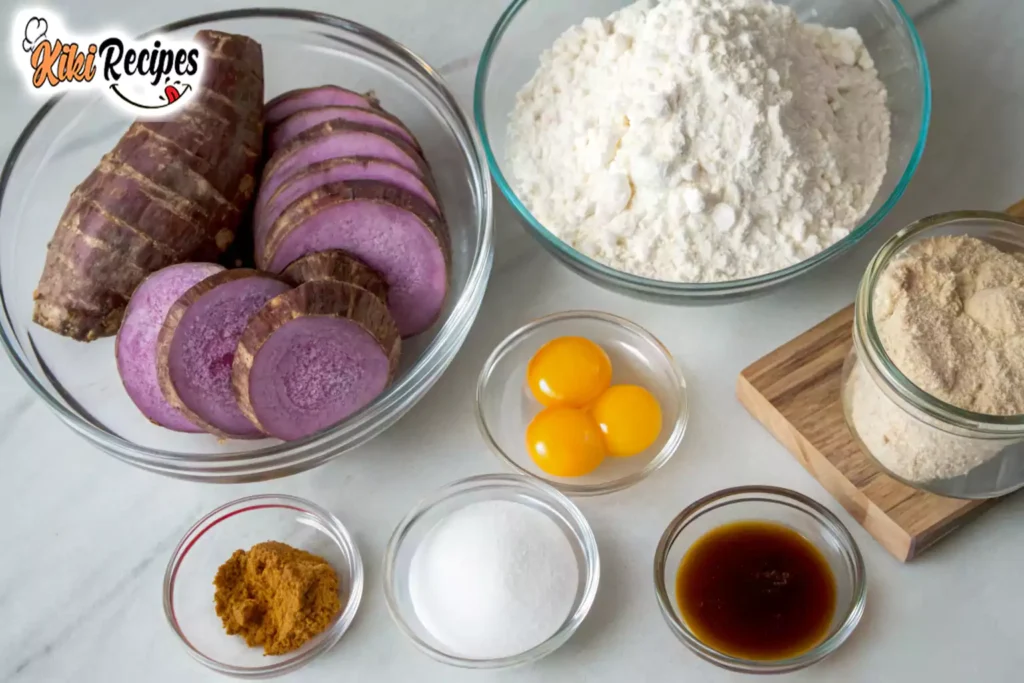Understanding Taro and Its Flavor Profile

Taro, a root vegetable that has been celebrated in many Asian cultures, is the star of this taro-flavored pancake recipe. But what exactly is taro, and why does it make such a great ingredient in pancakes? In this section, we’ll dive into the unique flavor profile of taro, its nutritional benefits, and why it’s perfect for adding an earthy yet subtly sweet twist to your pancakes.
1.1 What is Taro?
Taro is a starchy root vegetable that has been grown in tropical climates for centuries. It’s commonly used in a variety of dishes across Asian, African, and Pacific Islander cuisines. Taro root has a rough, brownish skin, but once peeled, its flesh is often a pale purple or off-white color. The texture is dense and slightly fibrous, yet once cooked, it becomes creamy and smooth, making it ideal for mashed potatoes, soups, and—yes—pancakes.
In many Asian cultures, taro is treated as both a sweet and savory ingredient. You might find it in baked goods, breads, or as a filling in dumplings. Its versatility makes it a must-have in various regional recipes. But what makes it a great pancake ingredient is its ability to blend seamlessly with batter, adding flavor without overpowering the traditional fluffy pancake texture.
1.2 Taro’s Flavor and Texture
So, what does taro taste like? The flavor of taro is quite subtle—earthy, with a hint of sweetness that isn’t too intense. It’s often compared to other root vegetables like sweet potato or yam, but with a more delicate flavor. When cooked, taro takes on a soft, creamy texture that’s almost buttery, which makes it perfect for incorporating into pancake batter. It adds both flavor and moisture without being overwhelming.
Its slightly nutty and starchy flavor is what makes it a great alternative to other common pancake flavorings like bananas or blueberries. It pairs wonderfully with both sweet and savory ingredients, so whether you’re looking for a dessert pancake or a more breakfast-friendly option, taro can handle it all.
1.3 Health Benefits of Taro
Beyond its delicious taste, taro also packs a nutritional punch. This humble root vegetable is loaded with fiber, vitamins, and minerals. Taro is particularly high in vitamin C, which supports your immune system and aids in collagen production, helping maintain skin elasticity. It also provides significant amounts of potassium, a mineral crucial for heart health and proper muscle function.
Taro is also known for its low glycemic index, meaning it has a slower, more steady effect on blood sugar levels compared to other starches. This makes it a great choice for people looking to control blood sugar or improve digestion. Additionally, it’s a good source of manganese, an essential nutrient that supports bone health and metabolism.
Incorporating taro into your pancake recipe adds not only flavor but also a nutritional boost. Whether you’re making vegan or gluten-free versions, the health benefits of taro make it a wonderful choice for an everyday breakfast or dessert.
1.4 Why Taro Works in Pancakes
Now that we’ve covered what taro is and why it’s good for you, let’s talk about why it’s the perfect addition to your pancake recipe. The creamy texture of cooked taro, when mashed or pureed, is ideal for adding a moist and rich base to pancake batter. It enhances the fluffiness of the pancakes while giving them a subtle sweetness that pairs perfectly with maple syrup or whipped cream.
Moreover, taro doesn’t overpower the flavor of the pancakes—it complements it. The pancake’s classic buttery and vanilla flavors marry well with taro’s earthy sweetness, creating a balanced taste that will satisfy anyone who loves unique flavors without sacrificing the traditional pancake experience.
When blended into pancake batter, taro contributes to a luscious, light, and fluffy texture. It holds the pancake’s structure while adding a touch of creaminess that you might expect from coconut or banana pancakes. Whether you choose to incorporate mashed taro, taro powder, or taro puree into the recipe, the results will always yield a beautifully soft pancake with a touch of exotic flavor.
In this first part, we’ve learned what makes taro such a fantastic ingredient for pancakes. Its mild, nutty flavor, combined with a smooth texture and rich nutritional profile, makes it an excellent choice for spicing up your typical pancake breakfast. Whether you’re cooking with fresh taro or its powdered form, you’re sure to end up with pancakes that are not only delicious but also packed with health benefits. Keep reading as we dive into the ingredients you’ll need to make your own taro-flavored pancakes in Part 2!
Ingredients Needed for Taro-flavored Pancakes

Now that we’ve explored the versatility and appeal of taro, it’s time to break down exactly what ingredients you’ll need to create your very own taro-flavored pancakes. Whether you’re making them from scratch or experimenting with variations, having the right ingredients is key to achieving a perfect balance of flavor and texture. Let’s dive into the essentials, as well as some optional ingredients that can elevate your pancake experience!
2.1 Basic Ingredients for Taro Pancakes
To get started with your taro-flavored pancakes, here are the key ingredients that will form the base of your recipe:
Taro
The star of the show! Fresh taro root is the best option for those who prefer an authentic, hearty flavor. You’ll need to peel and cook it before adding it to the pancake batter. Alternatively, frozen taro or taro powder can be used for convenience. Using taro powder will save you time, as it’s pre-cooked and can be added directly to your batter without any additional preparation.
Flour
All-purpose flour is the standard choice for making pancakes, ensuring they have the right balance of fluffiness and structure. If you’re looking to make your pancakes a bit heartier or need a gluten-free option, you can swap out the all-purpose flour for whole wheat flour or gluten-free flour blends.
Baking Powder
Baking powder is essential for making your pancakes light and fluffy. It reacts with the wet ingredients to create air bubbles, which give pancakes their signature rise and soft texture. Don’t forget to measure it accurately, as too much can cause a bitter taste.
Eggs
Eggs act as a binder and provide structure to the pancakes. They also add a rich flavor and help with the browning of the pancakes as they cook. If you’re vegan or have egg allergies, you can substitute eggs with flax eggs, chia eggs, or other egg alternatives.
Milk
Regular cow’s milk is commonly used in pancake recipes, but feel free to use plant-based alternatives if you want a dairy-free option. Almond milk, coconut milk, or oat milk work beautifully in this recipe, especially if you want to complement the taro’s subtle sweetness with a hint of coconut flavor.
Sweetener
While taro is naturally sweet, you may want to add a bit more sweetness to your pancakes. You can use sugar, maple syrup, honey, or even a touch of coconut sugar for a unique flavor. If you’re watching your sugar intake, consider using a sugar substitute like stevia or monk fruit sweetener.
2.2 Optional Add-ins and Variations
Once you’ve got the base ingredients ready, it’s time to get creative! Here are some add-ins and variations that can take your taro-flavored pancakes to the next level:
Coconut Milk or Coconut Flakes
For a tropical twist, add a bit of coconut milk into your batter. Not only will it pair perfectly with the flavor of taro, but it will also give your pancakes a creamier consistency. If you want a little extra texture, sprinkle some toasted coconut flakes on top as a garnish. This will add crunch and a boost of flavor.
Vanilla Extract
While taro has its own unique flavor, adding a bit of vanilla extract can enhance its natural sweetness. A teaspoon of vanilla will give your pancakes a lovely depth of flavor without overpowering the taro.
Cinnamon or Nutmeg
These warm spices work wonderfully with taro, giving your pancakes a comforting aroma. A pinch of cinnamon or nutmeg can make your taro pancakes feel like a cozy treat for chilly mornings.
Butter
For extra richness and flavor, incorporate melted butter into your pancake batter. This will create a more decadent, moist pancake that’s ideal for a special breakfast or brunch. You can also serve your pancakes with a dollop of whipped butter or a drizzle of melted coconut oil for added indulgence.
2.3 Tips on Choosing the Right Taro
When it comes to choosing taro, here are a few tips to make sure you’re getting the best option for your pancakes:
Fresh vs. Frozen Taro
If you can find fresh taro, that’s the best option for an authentic flavor. Fresh taro will need to be peeled and boiled or steamed until soft before mashing. On the other hand, frozen taro is a convenient alternative that’s already pre-cooked, saving you time in the kitchen. If you’re using frozen taro, simply thaw it before incorporating it into your pancake batter.
Taro Powder
For an even quicker option, taro powder can be used in place of fresh taro. Taro powder is made from dried and ground taro, and it’s perfect for when you’re short on time or don’t have access to fresh taro. Simply mix the powder into your dry ingredients and adjust the liquid content to achieve the desired pancake consistency.
Taro Quality
When selecting fresh taro, look for firm roots with minimal blemishes or soft spots. Taro should feel heavy for its size, and when peeled, the flesh should be creamy and free of any dark spots or imperfections. Avoid roots with a greenish tint, as this can indicate that they’re undercooked or unripe, which can lead to a bitter taste.

FAQs Section: Answering Common Questions About Taro-flavored Pancakes
Here are some frequently asked questions (FAQs) related to making delicious taro-flavored pancakes.
1. Is taro hard to cook for pancakes?
While taro does require some prep work, it’s not difficult to cook for pancakes. You’ll need to peel and cook the taro root before incorporating it into the pancake batter. You can either boil, steam, or bake the taro until it’s soft and mashable. Alternatively, you can use taro powder, which eliminates the need for cooking.
2. Can I use taro powder instead of fresh taro?
Yes, taro powder is an excellent alternative to fresh taro. It’s convenient and saves time since it’s pre-cooked and can be added directly to your pancake batter. Just adjust the liquid ratio in the recipe to ensure the batter has the right consistency.
3. How do I make taro-flavored pancakes vegan?
To make vegan taro-flavored pancakes, simply substitute the eggs with flax eggs, chia eggs, or another plant-based egg alternative. You can also replace dairy milk with almond milk, coconut milk, or oat milk to keep the recipe fully plant-based.
4. Can I make these pancakes gluten-free?
Absolutely! You can substitute gluten-free flour blends for the all-purpose flour to make gluten-free taro-flavored pancakes. Be sure to check your baking powder and other ingredients to ensure they are gluten-free as well.
5. What toppings pair well with taro pancakes?
Taro-flavored pancakes are delicious on their own, but they pair beautifully with various toppings like maple syrup, whipped cream, toasted coconut flakes, or even fresh fruit like bananas or strawberries. For an extra tropical flair, you can add a drizzle of coconut milk or a sprinkle of chopped nuts.
Conclusion: Enjoy the Unique Taste of Taro in Your Pancakes
Incorporating taro into your pancake recipe brings a delightful, exotic twist to your morning routine. The subtle earthy sweetness of taro combined with a fluffy texture makes for a pancake that is both satisfying and unique. Whether you opt for fresh taro or taro powder, your pancakes will have a creamy, rich texture that enhances the traditional pancake experience without overpowering it.
The great thing about taro-flavored pancakes is that they’re incredibly versatile. Whether you make them vegan, gluten-free, or with all the classic ingredients, you’re bound to end up with a stack of pancakes that are irresistibly delicious. Don’t forget to experiment with different toppings and variations to make the pancakes truly your own!
So, next time you want to try something new, why not give taro pancakes a try? They’re sure to impress family and friends alike with their unique flavor and creamy texture. Happy cooking, and enjoy every bite of this taro-inspired breakfast!

